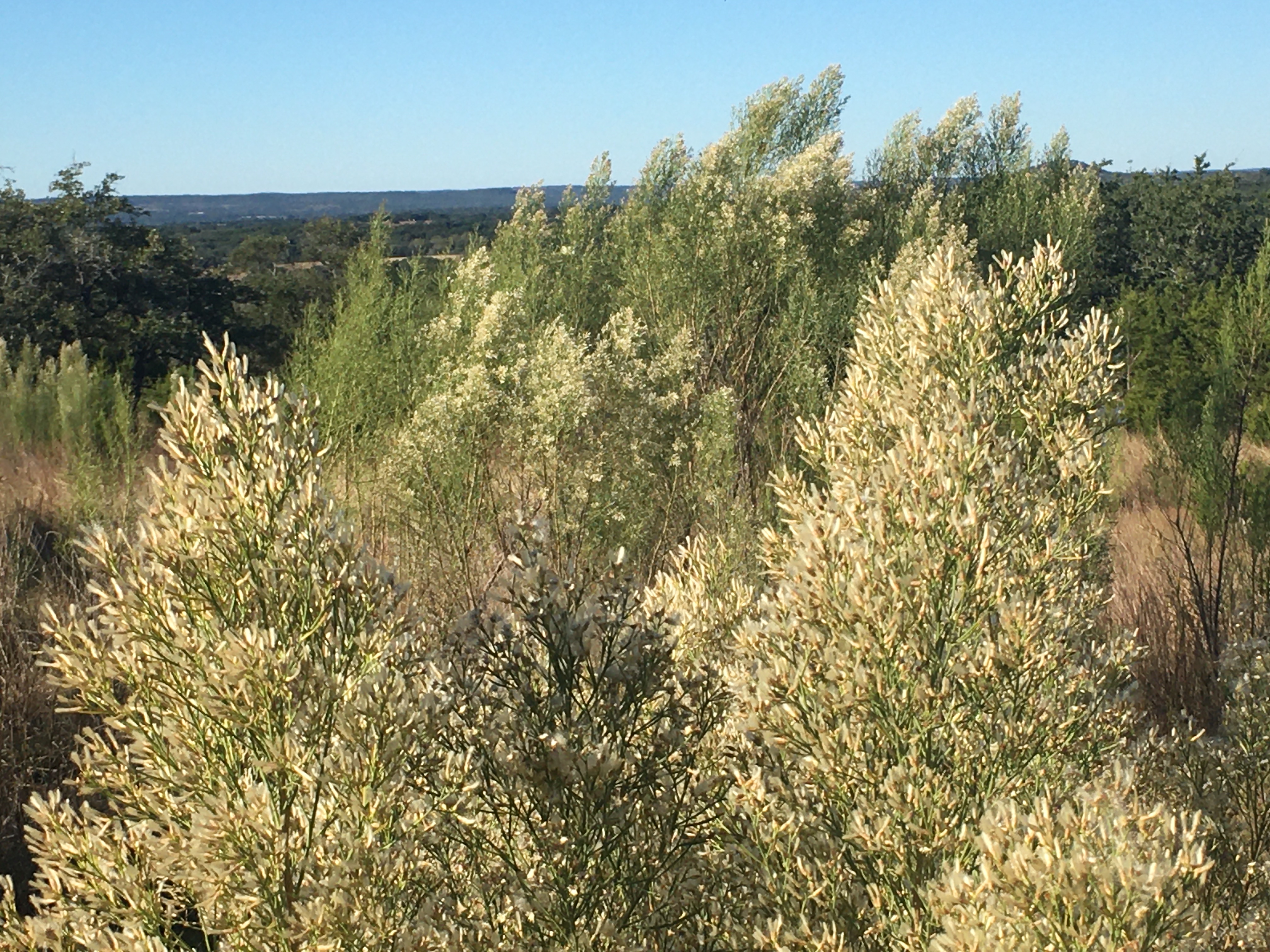Ah, the willow. It’s elegant, elongated branches gently swaying in the breeze is the stuff of children’s books and poetry.
Ah, willow baccharis. It’s elegant, elongated branches gently swaying in the breeze is the stuff of landowner nightmares.
If “a squirrel is just a rat with good PR” can the same be said for willows? Does willow baccharis, a Texas native and attractor of pollinators, simply suffer from bad public relations?
What is willow baccharis?
Willow baccharis is a smooth shrub in the sunflower family (charming, no?) that blooms in late summer and fall with small clusters of creamy white flowers. The plant is dioecious with female and male producing different flower heads. This perennial Texas native is adaptable, extremely heat tolerant, and can approach 13 feet in height.
The term “willow baccharis” tends to be the term used by Texas landowners for both Baccharis salicina and Baccharis neglecta. B. salicina is typically slightly smaller and it’s leaves less linear. It’s also known, more simply, as Great Plains false willow or groundsel tree. B. neglecta is also known, more tellingly, as Roosevelt weed, poverty weed, or New Deal weed.
And there are your first clues as to why this willow is considered more of rat and less of a squirrel.
Why the bad rap?
The neglecta in Baccharis neglecta indicates the shrub’s comfort growing in neglected or disturbed areas. This quality, combined with its willingness to grow in dry soil, led to its intentional propagation in the wake of the 1930s Dust Bowl period. B. neglecta was planted for erosion control and a quick way to rejuvenate the depleted soil. But, as noted by Aggie Horticulture, “the qualities that made it useful then make it an increasing problem now.” It spread quickly, overtaking forage plants, providing little to no value to grazing livestock and wildlife, and its deep roots can be water hogs. Willow bacccharis is also very flammable. As further noted by Aggie Horticulture: “Once established they are very difficult to eradicate, since livestock avoid them and they produce seeds prolifically.” Because it can take a dry and hot climate, the increasing drought conditions have allowed willow baccharis to invade not typically available areas such as lakes and streambeds.
What is it good for?
Yes, all of that sounds very bad, but willow baccharis did try to save us from the Dust Bowl. That’s good, right? For some other positives, here is what Lady Bird Johnson Wildflower Center has to say about B. neglecta:
“Although common, consider planting this shrub for its showy profusion of silky silver/white flowers. Roosevelt Weed is also a good nectar plant for many pollinators including some butterflies. Simple to care for: Full sun and low water.”
The Bell County Master Gardener further points out that it “rehabilitates damaged, worn-out soil” and, because it “tolerates high salt levels in the soil,” it makes it an “ideal plant for sea shore plantings to reduce beach erosion.”
Believe it or not, today you can find online tips on how to intentionally propagate this drought tolerant, deer resistant plant that is suitable for xeriscaping. And all this from a member of the sunflower family? Delightful.
Nope, it’s still a rat—how can I get rid of it?
Not sold on showy profusions of silky flowers from the plant that replenished the soil of Depression-era America? Tough crowd. But probably not as tough as willow baccharis. The long and short of this tall and stubborn plant is that there is no quick and easy solution—one study tried using goats to eat it with limited success. The goats ultimately preferred another stubborn invasive (salt cedar). Willow baccharis is more of a plant-by-plant eradication task. Here was the “Ask Mr. Smarty Plants” answer to a question on how to control Roosevelt weed:
“I wish I could offer an easier, quicker method; but, the most effective (and most environmentally-friendly) way to control the Roosevelt weed plants is to rogue them out, i.e., either pull them or dig them up. For the smaller ones it should be relatively easy to pull them and get most of the roots. The larger ones will probably require a little digging. It will take some time and effort and you have to be persistent, but you should be able to get them under control this way. Another possibility is to do a controlled burn of the area since they will readily burn. However, under the present conditions with the drought and extremely hot weather, this is definitely not the best idea.”
Control of Baccharis, published in 1968, offers a few mechanical control techniques including, in brief: plowing with a disc and then seeding with a high producing forage grass; shredding to remove the tops of mature plants; and using a tree grubber on a tractor. Also “hand grubbing provides effective control for seed baccharis.”
Willow baccharis is a tough one. Literally. But isn’t that what we love about Texas and Texans? Willow baccharis: Texas tough. Maybe this showy, flowering, pollinator-attracting, erosion-battling rat gently swaying in the breeze just needs better PR.









